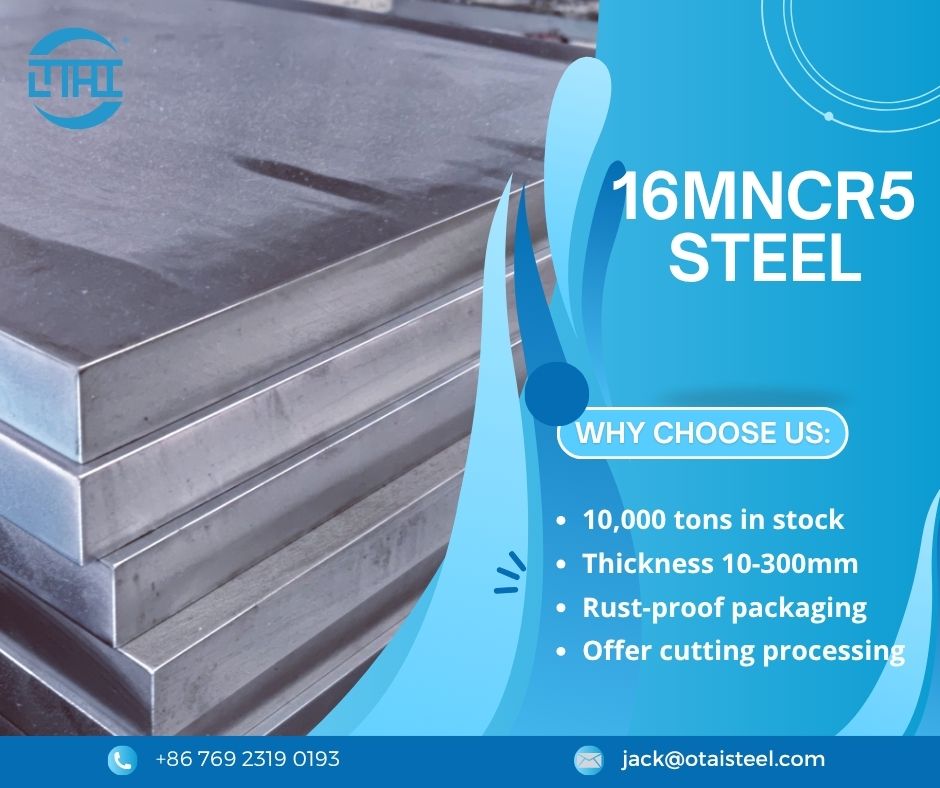 16MnCr5 Steel Properties: Key Features and Applications
16MnCr5 Steel Properties: Key Features and Applications
16MnCr5 steel is a low-alloy steel known for its strength, toughness, and hardness. Engineers use it for parts that require high mechanical strength and wear resistance, including gears, shafts, and automotive components. In this article, we’ll examine the key properties of 16MnCr5 steel, its common uses, and its role in various manufacturing processes.
🧪 What is 16MnCr5 Steel?
16MnCr5 is a manganese-chromium alloy steel. The name comes from its composition:
-
Carbon (C): 0.14% – 0.19%
-
Manganese (Mn): 1.00% – 1.30%
-
Chromium (Cr): 0.80% – 1.10%
This combination provides the steel with enhanced strength, toughness, and hardness, making it ideal for parts that undergo high mechanical stress, such as gears and axles.
🧬 Key Properties of 16MnCr5 Steel
16MnCr5 steel offers a combination of properties that make it suitable for demanding applications. These properties include high tensile strength, good machinability, and resistance to impact. Below is a table summarizing these characteristics:
| Property | 16MnCr5 Steel |
|---|---|
| Tensile Strength | 570 – 700 MPa |
| Yield Strength | 300 – 450 MPa |
| Hardness | 25 – 35 HRC |
| Impact Toughness | High resistance to impact and shock loading |
| Machinability | Good machinability in annealed condition |
| Weldability | Moderate (preheating for thicker sections required) |
🏗️ Applications of 16MnCr5 Steel
16MnCr5 steel proves valuable in various industries, especially for components requiring wear resistance and strength. Here are some of its primary uses:
1. Gears and Shafts
The steel is commonly used for manufacturing gears and shafts in automotive and industrial machinery. Its high strength, toughness, and wear resistance make it ideal for parts exposed to high mechanical stress.
2. Automotive Parts
In the automotive industry, 16MnCr5 plays a critical role in producing axles, differential gears, and crankshafts. The steel’s ability to handle impact and fatigue under high pressure makes it perfect for these demanding applications.
3. Industrial Components
Manufacturers use 16MnCr5 for making heavy-duty machinery components like gear wheels, transmission shafts, and bearings. It performs well in industrial machinery exposed to heavy loads.
4. Hydraulic and Pneumatic Systems
The steel’s wear resistance and corrosion resistance make it useful for components in hydraulic pumps and pneumatic systems that require precision and durability.
🔧 How to Process 16MnCr5 Steel
When working with 16MnCr5 steel, proper machining and heat treatment are essential to achieving the desired results.
1. Heat Treatment
One of the key advantages of 16MnCr5 is its ability to undergo hardening processes. Carburizing is a common treatment used to improve the surface hardness and wear resistance of the material. During carburizing, the steel is heated in a carbon-rich environment, which allows carbon to diffuse into the surface, creating a hardened outer layer while keeping the inner core tough and ductile.
-
Tempering is often performed after carburizing to adjust the hardness and relieve internal stresses.
2. Machining
16MnCr5 is easy to machine when in an annealed state. However, it becomes harder to machine after hardening. The material’s machinability improves with heat treatment, though it requires more effort and specialized tools after hardening.
3. Welding
16MnCr5 is weldable, but it does require preheating for thicker sections. After welding, a post-weld heat treatment may be necessary to prevent cracking and relieve stress in the material.
🔄 Alternative Grades to 16MnCr5 Steel
If you need a material similar to 16MnCr5, consider the following equivalents:
1. AISI 5115 (USA)
AISI 5115 is an equivalent grade offering similar chemical properties and mechanical performance. It is widely used in gears, shafts, and other automotive parts, just like 16MnCr5.
2. EN 100Cr6 (Europe)
EN 100Cr6 is another well-known equivalent in Europe. This steel offers slightly higher hardness and wear resistance, making it suitable for high-precision bearings and components that require fine mechanical properties.
3. JIS SCM415 (Japan)
The Japanese equivalent, JIS SCM415, is similar to 16MnCr5 in terms of mechanical strength and hardening ability. It is commonly used in automotive and heavy machinery applications.
🛡️ Advantages of 16MnCr5 Steel
Choosing 16MnCr5 steel offers several advantages:
-
High Wear Resistance: 16MnCr5 performs well in parts exposed to friction and abrasion.
-
Toughness: It retains strength and ductility under impact, which is essential for many heavy-duty applications.
-
Versatility: With its combination of properties, 16MnCr5 is suitable for a wide range of industrial applications, from gears to hydraulic components.
-
Hardenability: Its ability to be hardened through carburizing makes it an excellent choice for surface-hardened components.
💰 Cost of 16MnCr5 Steel
16MnCr5 steel costs more than carbon steel but is typically more affordable than stainless steel or higher-alloy steels. Prices vary based on factors such as region, processing requirements, and order volume.
For competitive pricing and high-quality 16MnCr5 steel, Otai Special Steel provides a wide range of options, including custom cutting, heat treatment, and other specialized services.
🏅 Why Choose Otai Special Steel?
Otai Special Steel offers a comprehensive selection of 16MnCr5 steel and other alloys. Here’s why we are the best choice for your needs:
| Benefit | Details |
|---|---|
| Large Inventory | We maintain a large stock of 16MnCr5 steel in various sizes and specifications. |
| Custom Solutions | We offer custom cutting, heat treatment, and other services tailored to your requirements. |
| Global Shipping | Fast, reliable delivery to locations worldwide. |
| Quality Assurance | We conduct rigorous quality checks to ensure the best products. |
❓ FAQ: Frequently Asked Questions about 16MnCr5 Steel
Q1: What are the best alternatives to 16MnCr5 steel?
A1: AISI 5115, JIS SCM415, and EN 100Cr6 are good alternatives, depending on the required properties.
Q2: Is 16MnCr5 suitable for welding?
A2: Yes, it is weldable, but thicker sections require preheating.
Q3: How can I improve the wear resistance of 16MnCr5?
A3: Carburizing followed by tempering is an effective way to improve wear resistance and surface hardness.